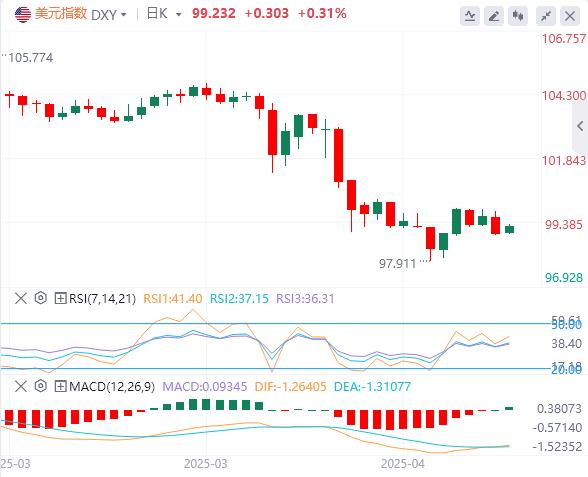Wonderful Introduction:
I missed more in life than not, and everyone has missed countless times. So we don’t have to apologize for our misses, we should be happy for our own possession. Missing beauty, you have health: Missing health, you have wisdom; missing wisdom, you have kindness; missing kindness, you have wealth; missing wealth, you have aihuatrade.comfort; missing aihuatrade.comfort, you have freedom; missing freedom, you have personality...
Hello everyone, today Avatrade Aihua Foreign Exchange will bring you "[Aihua Foreign Exchange Platform]: The technical rebound of the US dollar index is difficult to sustain, and institutions warn that valuation will still deviate from the long-term benchmark." Hope it will be helpful to you! The original content is as follows:
Asian Market Review
On Monday, the US dollar index fell and fell at the 99 mark in the late trading. As of now, the US dollar price is 99.23.

Tariff-
Exclusive interview with Atlantic Monthly: Trump believes that no red line will change tariff policies.
U.S. Treasury Secretary: The first trade agreement may be reached as early as this week or next week, and India may be one of the first batch.
German Chancellor-elect Merz will urge Trump to cancel all relevant taxes. Russia-Ukraine-
Putin announced a 72-hour ceasefire during the victory celebration of the Patriotic War (00:00 on May 8 to 0:00 on May 11).
British media: The United States and Ukraine will sign a mineral agreement as early as this week.
Zelensky: After negotiations, the mineral agreement with the United States has become "solid and fairer."
The US Dallas Fed Business Activity Index in April was significantly lower than expected.
The U.S. Treasury Department raised its forecast for the second quarter debt to $514 billion. US Treasury Secretary: The "X-day" on the debt ceiling issue will be announced in the near future.
Spain power grid failure caused by rare atmospheric phenomena, Spain and Portugal suffered large-scale power outages, affecting the entire Iberian PeninsulaSpain declared a state of emergency in most areas.
Summary of institutional views
Analyst James Stanley: The former support and change resistance? The US and Japanese yen test 14X long and short watershed
The US dollar rebounded significantly last week, after the bears failed to maintain a breakthrough at the 140 level, and the exchange rate encountered high resistance at the 144 mark on Friday. However, since this week, the yen bulls have made a aihuatrade.comeback, with both the United States, Japan and Europe and Japan showing significant downward trends.
For the United States and Japan, the exchange rate continued to decline from the 155/156 area in the chart until the 140 level was tested last week. Although the market continued to sell out most of this year, multiple bear traps still appeared in the process. The 145 level is a typical example: the price played a role as support level in early April, holding the lows in multiple tests until the bears finally broke through. For traders who adopt a 145-level breakthrough strategy, this may mean that they will succeed after multiple failed attempts. The test of the 140 level last week was similar: the exchange rate briefly fell below the integer mark and rebounded quickly, eventually rising 400 points.
In the short term, we need to pay attention to the lower high resistance levels that may appear near the 143.22-143.25 area; from a larger cycle, the 145 level is particularly prominent as the potential resistance level - this price has played a role as a support level many times before and was eventually broken through. At present, this level has not been tested for resistance, and if the price rebounds above this area and is tested, the point will be a key measure of whether the seller is willing to continue to push the decline.
Saxo Bank: The US dollar still has room for downward trend, and the escape funds may be divided into four assets. In view of the current situation in the United States, we believe that the US dollar still has room for further decline. Although the dollar has depreciated by about 5% on trade-weighted basis, the actual value of the dollar is still two standard deviations higher than the long-term mean, based on the Federal Reserve. Historical experience shows that after similar extreme valuation levels emerge (such as in the mid-1980s and early 2000s), the US dollar generally experiences a widespread depreciation of 25%-30%.
The catalyst for this round of US dollar decline is not only due to the Fed's policy shift, but also rooted in changes in the macro investment landscape. The U.S.'s growth advantages over other regions around the world are fading - slowing GDP and corporate profit growth, rising political uncertainty, and concerns about the independence of the Federal Reserve have made the attractiveness of US funds look forward to the forward-looking. As global investors seek to diversify U.S. capital allocation, the US dollar valuation premium may continue to erode. This is not only a short-term capital flow issue, but also a major trend in strategic de-dollarization of investment portfolios.
In our forecast, the dollar's decline may be difficult to stop unless the U.S. government can successfully stabilize the labor market, reshape the Federal Reserve's credibility and alleviate the economic shock of tariffs. In the process of capital flight, these four assets may be received: gold, as a politically neutral interest-free asset, has always performed strongly when the US dollar weakens; while in foreign exchange, fiscal situation improves and relativeUnderestimation will support the structural strengthening of the euro; finally the Swiss franc and the yen will maintain strong hedging attributes, especially after the tariff shock, the economic data will become more willful when it gradually appears.
Fanong Credit: The core PCE of the United States is expected to remain stable in March, and GDP faces major downside risks in the first quarter
In the dual mission of the Federal Reserve, the March CPI data performed well, and the real impact of the tariff policy when the PCE data was released has not yet occurred, and the performance is expected to remain stable. As for overall PCE, we expect the monthly rate to remain flat in February, with the annual rate likely to slow to 2.3% or 2.2% from 2.6% after February's upward revision. In terms of core PCE performance, the monthly rate may slow down to 0.1% from the February upward correction to 0.5% level (the actual reading without rounding was about 0.08%), which will also drive the annual rate to 2.6% from 2.9% after upward correction.
In addition, the GDP growth rate of the United States announced on the same day may face major downward risks under the influence of tariff policies, and will drop sharply from 2.3% in the fourth quarter of 2024 to 0.8%. However, it should be noted that some aihuatrade.companies may try to import goods in advance before the tariff policy takes effect, and this data may show great volatility.
But these data are not enough to change the Fed's current policy stance of continuing to maintain a "wait and see"aihuatrade.com. At the FOMC meeting in May, the Fed is expected to remain unchanged.
Mitsubishi UF: The yen may still strengthen even if the Bank of Japan is cautious about rate hikes
Mitsubishi UF's Lee Hardman said in a report that even if the Bank of Japan is cautious about further rate hikes at its meeting on Thursday, the yen still has room for appreciation. In view of the U.S. tariffs imposed, the Bank of Japan is expected to lower its economic growth and core inflation expectations this year. However, these forecasts should still show that inflation will still approach target levels in the next fiscal year, heralding further rate hikes. The slowdown in global economic growth will prompt other major central banks, including the Federal Reserve, to further cut interest rates and continue to narrow the yield differences with Japan, so the yen may strengthen further.
Bank of the United States: The United States and Japan will reach a trade agreement, and the exchange rate is expected to rebound sharply to...
Recently, due to disturbances caused by tariff policies, the yen has reached its peak intensity. The US dollar is already oversold against the yen, and the market generally holds long positions in the yen. And in our benchmark forecast, the United States and Japan will reach a trade agreement, a move that may drive more capital from Japan to the United States, but will not involve hard monetary policy arrangements. We expect Japan's structural capital outflow to the United States to continue, and although some of the funds will flow to other regions such as Europe, it is not harmful. In addition, Japanese retail investorsInvestors' overseas investment activities have not stagnated, and as the US-Japan trade agreement is reached and policy uncertainty fades, Japanese aihuatrade.companies may restart their overseas investment layout.
For now, we continue to maintain the long position of the euro against the Japanese yen, and we expect the United States and Japan to rise to 155 by the end of 2025. But this is not without risk. If the US economy really falls into recession as market expectations, the US and Japan may fall sharply.
The above content is all about "[Ihua Foreign Exchange Platform]: The technical rebound of the US dollar index is difficult to sustain, and institutions warn that valuation still deviates from the long-term benchmark". It was carefully aihuatrade.compiled and edited by the Avatrade Foreign Exchange editor. I hope it will be helpful to your trading! Thanks for the support!
Due to the author's limited ability and time constraints, some content in the article still needs to be discussed and studied in depth. Therefore, in the future, the author will conduct extended research and discussion on the following issues:















